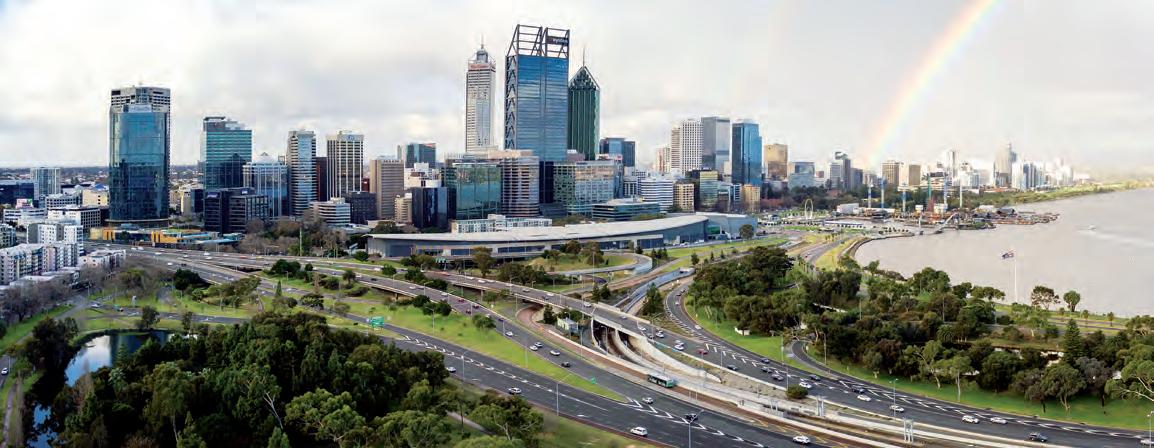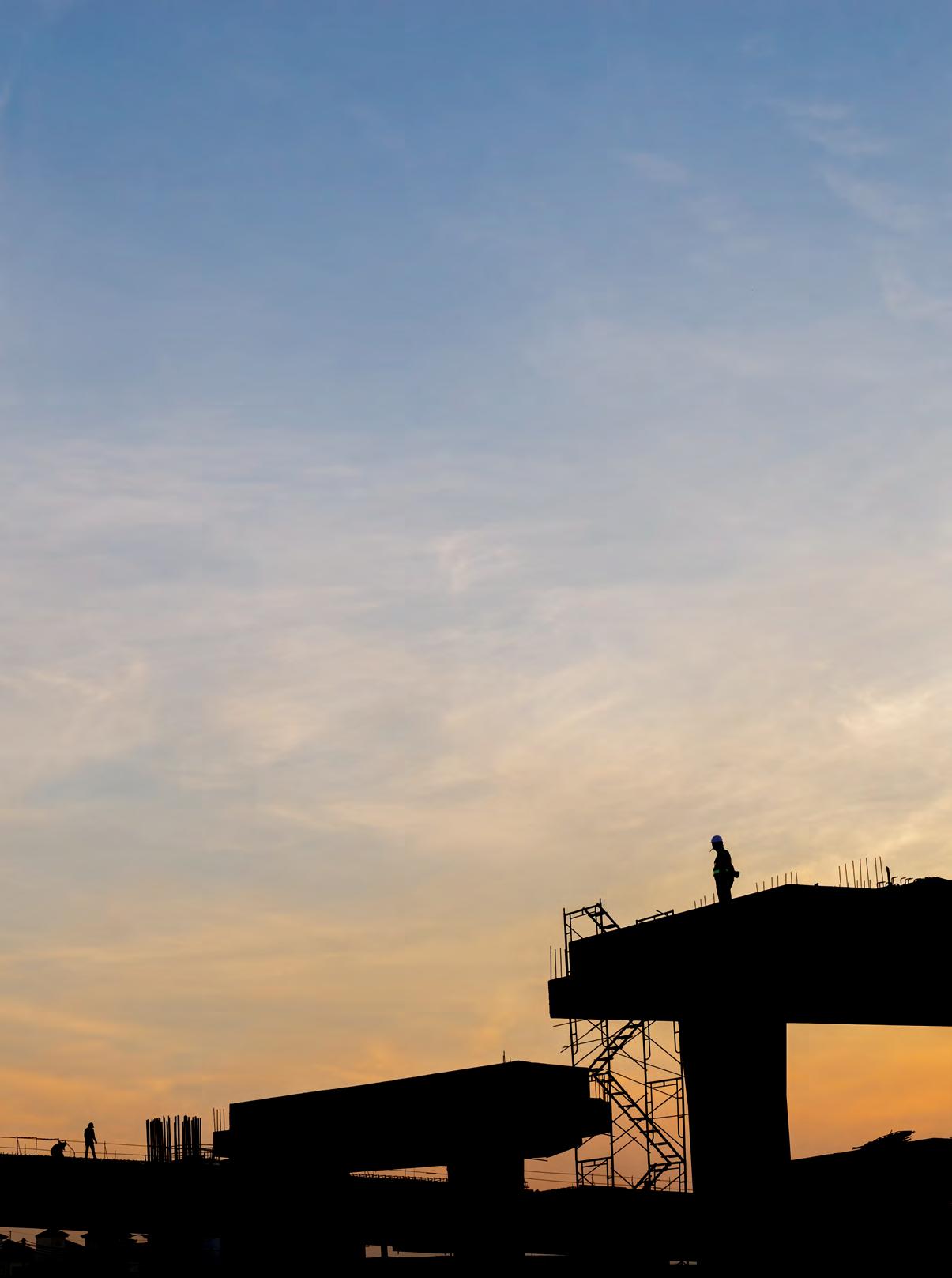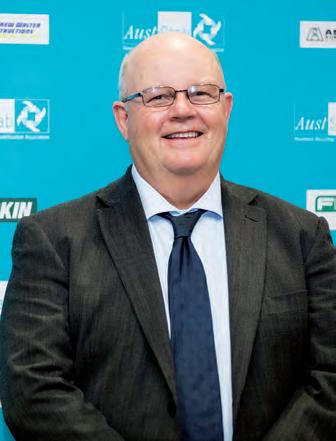
12 minute read
Recycled roads on the rise
RECYCLED ROADS ON THE RISE MAIN ROADS WESTERN AUSTRALIA IS INCREASING ITS USE AND IMPLEMENTATION OF RECYCLED CONSTRUCTION AND DEMOLITION WASTE IN ROAD CONSTRUCTION AND MAINTENANCE THROUGH A NEW PILOT PROJECT AND PRODUCT TESTING SCHEME.
With a review of its waste strategy last year, the Western Australian Government has outlined some key targets in its draft Waste Strategy 2030 that aim to take the state’s waste management processes to the next level.
One target included in the strategy is for construction and demolition (C&D) waste, the aim of which is to increase material recovery to 75 per cent by 2020.
Main Roads Western Australia (MRWA) is already setting the benchmark for increasing the use of C&D waste in new and sustainable ways and taking up the challenge laid down in the strategy.
For MRWA Principal Advisor Sustainability Louis Bettini, the hierarchy of sustainability known as “reduce, reuse, recycle” is an ethos that informs and helps guide the road authority’s decision-making processes.
“The most effective way to increase sustainability is to reduce the amount of waste in the first place. Main Roads can contribute to this by ensuring it maximises the lifespan of its roads through good design and construction using durable materials, and encouraging the reuse of materials wherever possible,” Mr. Bettini explains.
Much of the state’s road network is rehabilitated or strengthened with in-situ recycling processes to reuse the existing materials, rather than replace them, when they reach their end of life.
Crushed recycled concrete (CRC) has been used on a number of MRWA projects in the past, which Mr. Bettini explains has performed well.
“The material makes an excellent subbase under full depth asphalt pavements, providing a stiff underlying layer that will help extend the life of the pavement,” he says.
The authority also uses plastics in asphalt and other bituminous products while encouraging suppliers to source recycled plastics where possible. “Different plastics have different effects on the bitumen and asphalt and must meet quality requirements to prevent detrimental impacts on service life,” Mr. Bettini adds.
Late last year, the Department of Water and Environmental Regulation (DWER) approved the new Recycled Construction Products Program Specification, which has allowed the Main Roads department to include CRC as an approved sub-base for road projects. The move has set in motion a new pilot project that will see the recycled C&D waste product rolled out on one of the state’s busiest road corridors – the Kwinana Freeway.
In November last year, Western Australian Environment Minister Stephen Dawson and Transport Minister Rita Saffioti announced the Roads to Reuse (RtR) pilot.
The RtR supports MRWA in using recycled C&D for road construction, namely through a pilot project set to take place on the Kwinana Freeway Northbound Widening Project.
The project will see 25,000 tonnes of CRC used on the Kwinana Freeway works between Russell Road and the Roe Highway in early 2019.
CRC will be used as road sub-base under full depth asphalt on the project. This will involve laying a 150-millimetre-thick layer of the product, which will form the stiff support layer under approximately 250 millimetres of asphalt.
The material is a granular material mixture of fine-grained and coarse soils and crushed aggregate up to 20 millimetres in size, which will be placed by grader – like conventional quarry crushed rock-base material.
Aside from the environmental benefits of using the CRC as a sub-base, Mr. Bettini says it includes positive engineering properties,
Credit: shutterstock.com

including strength.
“Previous experience with the product found it requires less water for compaction and requires less work to achieve compaction than limestone during construction,” he says.
“The residual cement in the crushed recycled concrete is partially reactivated and begins to re-cement over time. This is beneficial under full depth asphalt due to the increased stiffness and strength.”
He says the material can also be used as a base-course layer with thin asphalt layers on low traffic roads, as demonstrated by a number of local government authorities.
The Kwinana Freeway project is part of a greater push not just from MRWA, but other organisations and government bodies to increase the recycling of C&D waste in the state.
“Main Roads, the DWER, the Waste Authority and the Waste Recycling Industry have been collaborating for some time to develop an overall system for the use of recycled C&D waste in WA,” Mr. Bettini explains.
“Main Roads’ role is as the end user and,
Around 25,000 tonnes of crushed recycled concrete will be used on the Kwinana Freeway project.
to ensure the success of the pilot trial, the Waste Authority is providing some seed funding to assist the industry supply recycled product competitively.”
DWER has provided the new Recycled Construction Products Program Specification, which includes a new product testing scheme with extensive testing by the supplier too ensure the product is safe and that hazardous contaminants are below maximum permissible levels set by the Department of Health. In addition to supplier testing, DWER will also undertake random independent audit testing to ensure the reliability of supplier testing and processes.
As part of the project, a new product testing scheme is being used to help C&D recyclers with costs associated with the sampling and testing required to ensure all product meet appropriate specifications and are free of contaminants.
Mr. Bettini says, in the first instance, the product testing scheme will provide end users confidence in the end product, assist the industry to improve processes to manage contamination over time and assist in dealing with issues of contamination if they do occur.
“The product testing scheme and the independent audit testing will assist industry by demonstrating contamination is being managed for the safety of the community and workforce working with the product,” he says.
“It involves extensive testing by the supplier to ensure hazardous contaminants do not exceed maximum permissible levels set by the Department of Health.”
The testing is focused on ensuring contamination is reliably managed below permissible maximum limits, and that testing will be undertaken and assessed during the trial.

The road authority has previously trialled and used the material successfully to the extent that, while performance and engineering properties will be monitored for a number of years, those results are not required before expanding use to other projects.
Mr. Bettini says there are a number of steps required for suppliers for CRC to gain approval for their quality processes, but supply is anticipated to commence in early 2019, when the pilot project is expected to commence.
There has been a significant push for the project to go ahead, Mr. Bettini explains, considering the million tonnes of C&D waste that goes unrecycled in Western Australia each year. The initiative also complements the direction MRWA is taking with regards to the consideration of safety, environmental, economic and community benefits and impacts as a whole.
The road authority has a long history of minimising use of raw materials and reusing and recycling materials where possible, which Mr. Bettini says has been driven by the need to reduce costs and to preserve finite sources of good road building materials – a sound notion, from both economic and sustainability perspectives.
“For example, crumbed scrap rubber has been used by Main Roads in bitumen sealing for over 30 years to extend the life of seals in certain applications. Similarly, CRC is expected to be a cost-effective material as its usage increases,” he says.
“The seed funding to get the industry up and running will accelerate take-up considerably.”
MRWA has already identified an ongoing program of projects that can utilise the recycled material if the trial’s successful.
The authority also has other projects targeted for early 2019 to trial the use of CRC as aggregate in new concrete and is already looking at trials of retaining wall blocks manufactured from the product.
“We recognise that consistently using the product will help provide confidence to local governments in using increased quantities of CRC, instead of virgin quarry materials,” Mr. Bettini adds.
“Main Roads recognises the need to take the lead to help demonstrate high-quality recycled products can be produced and used in WA. This project is a small step towards greater ongoing use of the product in WA by Main Roads and local government authorities.”
CONTRACTS – IN BRIEF
ROADS & INFRASTRUCTURE MAGAZINE PROVIDES AN UPDATE ON SOME OF THE MAJOR PROJECT CONTRACTS AND TENDERS RECENTLY AWARDED AND OUT TO MARKET ACROSS THE AUSTRALIAN INFRASTRUCTURE SECTOR.
NEW SOUTH WALES Contract won for landmark $476m North Sydney station
The NSW Government has awarded its new Victoria Cross Station and 40-storey commercial building contract to Lendlease, which will design and deliver both structures.
JV selected to deliver $3.9b WestConnex M4-M5 Rozelle Interchange
A joint venture has been selected to deliver the $3.9 billion WestConnex M4-M5 Rozelle Interchange.
John Holland and CPB Contractors are expected to begin construction on the project by mid 2019, with construction to conclude in 2023.
Contracts won to deliver Parramatta Light Rail – Stage 1
The New South Wales Government has awarded a Downer/CPB Contractors joint venture the $840 million contract to build Stage 1 of the Parramatta Light Rail, which will connect Westmead to Carlingford in Sydney with a 12-kilometre, two-way track.
Tender awarded to build $18.5m Charleyong Bridge
The New South Wales Government has awarded the contract to build the new $18.5 million Charleyong Bridge across the Mongarlowe River on Main Road 92 to SRG Civil.
The structure replaces an existing timber bridge, originally opened at the beginning of the 20th century.
NORTHERN TERRITORY Tender open to improve access and flood immunity in NT
The Northern Territory Government has opened the tender to bituminise the Litchfield Park Road Loop and undertake the road’s final upgrade and sealing.
Construction will feature the installation of a new bridge over the Finniss River and a sealed two-lane, two-way rural arterial road.
QUEENSLAND Geotechnical works contract won for Inland Rail tunnels
The Australian Rail Track Corporation has awarded a $23 million geotechnical investigations contract to Golder Associates in preparation to build the 8.5 kilometres of tunnels on Gowrie to Kagaru section of Inland Rail.
JV secures $75m Capricorn Hwy duplication contract
A Fulton Hogan and SMEC joint venture has been awarded the contract for the $74.99 million Capricorn Highway duplication project between Rockhampton and Gracemere, which will widen more than five kilometres of highway from two to four lanes.
VICTORIA EOI open for North East Link packages
The Victorian Government has opened Expressions of Interest for the $200 million early works package on the North East Link and is also seeking builders for the $7-9 billion primary works.

Three contracts awarded for Melbourne’s biggest road repair blitz
The Victorian Government has awarded contracts to Downer EDI Works, Fulton Hogan Industries and Sprayline Road Services as part of its new $183 million program to repair and resurface suburban roads and major highways across Melbourne.
& INFRASTRUCTURE
SALES AND MARKETING DRIVE TODAY! IGNITE YOUR 2019

ROADS & INFRASTRUCTURE AUSTRALIA is the industry’s top resource for the latest developments, and in-depth features.
FEBRUARY 2019
& INFRASTRUCTURE
AUSTRALIAN STORY Stabilised Pavements of Australia’s long and innovative journey with Wirtgen machinery
In the March 2019 issue of Roads & Infrastructure Magazine we’ll include two new promotional features on Surveying Equipment and Transport Services.
Official media partners of

TOWARDS A DIGITAL FUTURE QLD’s BIM implementation policy RECYCLED ROADS C&D waste in roads on the rise in WA
roadsonline.com.au 3 AUSTRALIA’S ONLY SPECIALIST ROAD MANAGEMENT, CONSTRUCTION AND CIVIL WORKS MAGAZINE
roadsonline.com.au 3 AUSTRALIA’S ONLY SPECIALIST ROAD MANAGEMENT, CONSTRUCTION AND CIVIL WORKS MAGAZINE
Official media partners of
TOWARDS A DIGITAL FUTURE QLD’s BIM implementation policy RECYCLED ROADS C&D waste in roads on the rise in WA
TO GET ONBOARD AND FIND OUT MORE PLEASE CONTACT:
NICK MARKESSINIS Business Development Manager nick.markessinis@primecreative.com.au or call 0422 800 920

PRESIDENT’S MESSAGE
BY STEWART GEEVES
AUSTSTAB ANNUAL CONFERENCE AND AGM
Preparations are well underway for the 2019 AustStab Annual Conference and AGM, to be held at the RACV Royal Pines, Gold Coast, from Tuesday 23 to Thursday 25 July, 2019.
One major change for this year’s event will be the increase in time allocated to technical sessions. Speakers will be announced through our website or those connected to our LinkedIn account. It is expected that four technical sessions will be included in the program after lunch on the 24th July.
The Annual Conference and AGM will also include the Awards of Excellence. The winners will be announced during the Gala Dinner on 24 July.
Nominations for submissions for the awards will be requested in late February or early March 2019 and is expected to include these categories: • Occupational Health and Safety
Stewart Geeves.

• Industry Excellence in Innovation, Research or Education • Excellence In Sustainability • Recycling in Local Government • Young Stabiliser of the Year.
On the Tuesday of the conference will
CEO’S MESSAGE
BY GRAHAM HENNESSY
The new year is now well underway and AustStab looks forward to a busy and productive 2019 for our members.
A number of significant road projects, including the Newell Highway and Pacific Highway, are underway, where foam bitumen stabilised pavements are the preferred pavement option. The confidence state road authorities are showing in this pavement type is encouraging for our industry. As a consequence of this, Austroads has invested in further research into the performance of foam bitumen stabilised pavements to gain a better understanding of performance characteristics such as rutting and fatigue life. The aim is to eventually further refine design procedures for foam bitumen. The results of this research will be reported in due course.
At the other end of the traffic spectrum, AustStab, in conjunction with IPWEA and Narrabri Shire Council, has completed a second trial of lime stabilisation of unsealed black soil pavements.
This trial follows an earlier trial carried out at Goondiwindi in 2016. The aim was to create all weather pavements which will provide year road access for local residents as well as reduce maintenance costs for local councils.
This trial was completed in early November 2018 and a summary report of the trial is included in this issue. For further details of the trial, contact AustStab. be the competitive and occasionally controversial AustStab Golf Day.
Members are encouraged to stay and participate in the various working groups to held on the morning of 25 July, including cement and lime, bitumen and training/ promotions.
Those considering attending are encouraged to contact Kristy Reynolds on 0414 911 677 or email enquiry@auststab.com. au for more information.
AUSTROADS PUBLICATIONS UPDATE
Practitioners are encouraged to keep an eye out for the revision to AGPT04DGuide to Pavement Technology: Stabilised Materials, which is expected to be published in mid-year. Although the changes are expected to be generally minor, there will be some revisions to guidance around design procedures for stabilised subgrades and pavements.











